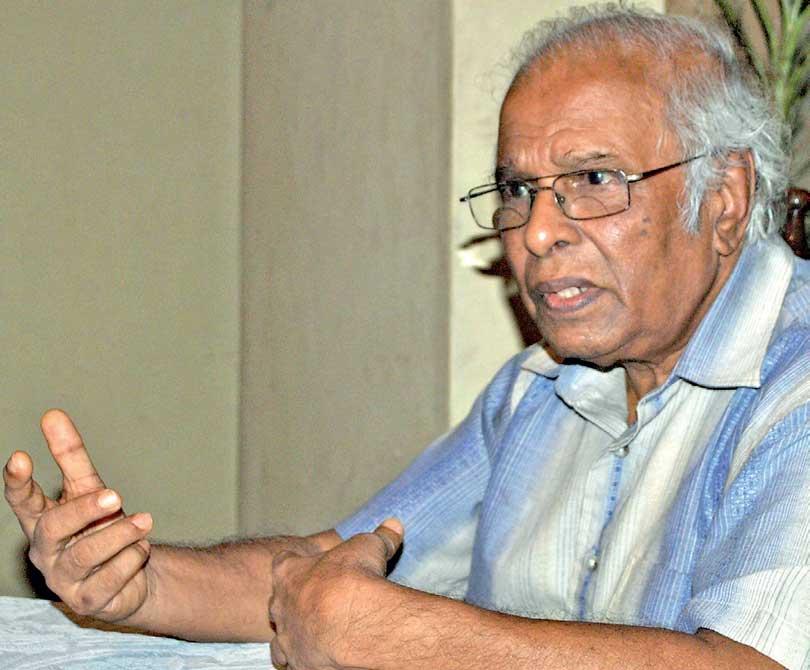Reply To:
Name - Reply Comment

 In the 1960s the Sinhala cinema attempted to develop a distinct national identity. It sought to do this mainly by obliterating the Indian influence. To do that, it was necessary to nurture and mobilise an entirely new generation of actors, writers, directors, and even producers. Looking back today, to me it seems that the experiment, though not totally successful, did succeed in shaping the cinema, particularly due to a shift in artistic taste among people brought about by free education. The 1962 National Film Commission highlighted the need for such a shift, if at all because notwithstanding Lester James Peries’s groundbreaking Rekava, film producers continued to prioritise studio lit, box-office led movies that differed very little in conception and mood from what was being churned out in Bombay and Madras. Those who emerged as actors, writers, and directors thus determined to forge a local idiom in the movies they were involved with. Among these pioneers was Tissa Liyanasuriya.
In the 1960s the Sinhala cinema attempted to develop a distinct national identity. It sought to do this mainly by obliterating the Indian influence. To do that, it was necessary to nurture and mobilise an entirely new generation of actors, writers, directors, and even producers. Looking back today, to me it seems that the experiment, though not totally successful, did succeed in shaping the cinema, particularly due to a shift in artistic taste among people brought about by free education. The 1962 National Film Commission highlighted the need for such a shift, if at all because notwithstanding Lester James Peries’s groundbreaking Rekava, film producers continued to prioritise studio lit, box-office led movies that differed very little in conception and mood from what was being churned out in Bombay and Madras. Those who emerged as actors, writers, and directors thus determined to forge a local idiom in the movies they were involved with. Among these pioneers was Tissa Liyanasuriya.
Rohana Tissa Liyanasuriya was born in 1936 as the badapissa of a family of six boys and one daughter in Borella, where he continues to live today. “My father spoke very little and he was firm and strict in how he brought us up. My mother, by contrast, was more nondescript.” If not entirely middle class, the Liyanasuriyas were better off than most. They also came face to face with the horrors of the Second World War, although as Tissa recalls, “We didn’t fear it much, not even when Japan bombed the harbour.” It was then that his father decided to put him into a school. “He was serious in bringing us up, and especially serious when it came to educating us.” The school decided on for young Tissa was St Joseph’s.
From movies and documentaries Tissa would shift to TV. By the time the medium first came to Sri Lanka, he had participated in various workshops abroad, such as Asia-Pacific Institute for Broadcasting Development (APIBD) in Malaysia and Sender Freies Berlin in West Germany
Coming from a Sinhala and Buddhist background, Tissa initially found it difficult to adjust to the school, which he remembers today as being “exclusively Christian and English, with just one period for Sinhala and Sinhala literature.” Despite these limitations, Tissa and his friends made the most of it: “We were the driving force behind the College Sinhala magazine as well as the Sinhala Literary, Drama, and Debating Societies. Upali Attanayake was quite active as a debater, Shyamon Jayasinghe who later wound up as the first pothe gura in Maname had an unquenchable thirst for drama, and together with Sidney Attygalle we did what we could to resuscitate local culture through these clubs. Mind you, even “Piliraw” the Sinhala Magazine had to be compiled by us; school officials paid very little attention to them, compared with the attention they lavished on the more ‘Western’ societies and clubs. Our Sinhala teacher, Victor Hapuarachchi, helped us a lot.” On the other hand, Tissa remembers the quality of the education he received well: “You couldn’t fool the teachers. One mistake and you were out. No doubt this razor-sharp regard for meticulousness had a big say in my career as well, where the slightest mistake, back then, could cost an entire production.”
From school he graduated to radio drama, through which he met his first figure of destiny, K. A. W. Perera. “Perera had an instinctive, assured feel for dialogues, as different as they were from the stagey, contrived, unconvincing dialogues in Sinhala movies. Like me he came from a largely urban background, and like me he was quite conscious of his Sinhala and Buddhist roots. These were reflected in his dramas also. Under him, I flourished. Later, when he was selected and taken in as the dialogues writer for Rekava, I found an opening and landed in the assistant director’s chair aboard Lester’s second film, Sandeshaya. I worked alongside Vijaya Abeydeva and our only female crew member, Sumitra Gunawardena. We were at Belihuloya, where the film overran the budget and ended up reaping big profits at the box-office despite a huge cost of Rs. 500,000. And yes, we enjoyed every minute of it.”
If K. A. W. was his first figure of destiny, Lester soon became his second. “One year working with him was the equivalent, I would say, of a film course. From Lester James Peiris I learnt how to be careful in selecting the shots and how to manoeuvre actors to get the effect you desired as the director. It’s not easy, and it certainly was much more difficult then. But Lester had this flair for detail. Nothing escaped his eye. To have someone like that teach me how to direct a movie like Sandesaya, with its elephantine sets and all star cast, was my luck. Once shooting wrapped up and we went back home, he wrote a terse, to the point letter recommending me. I will never forget that. We also had an unlikely common link: I had been taught at St. Joseph’s by the formidable Rev. Father Peter Pillai, who had taught Lester at St Peter’s and had, reputedly but fruitlessly, tried to get the budding artist to turn to medicine like his father.”
With the emancipation of the local cinema from the stage, an innovation fathered, you could say, by Lester himself through Rekava, the industry soon became pocked with adventurers out for the pleasure of making a “picture” and earning large profits. Among these adventurers was an unlikely trio: Shesha Palihakkara, the dancer-actor who had made his breakthrough in Mathalang and had later been cast as a stilt-walker in Rekava; Mike Wilson, “a fast-talking American, originally from New Zealand, then living in Sri Lanka”; and Arthur C. Clarke. The three of them would form Serendib Pictures, and their debut film, Ran Muthu Duwa, became an opportunity for the actor, the fast-talker, and the futurist to explore the hidden underwater treasures of Koneswaram. Liyanasuriya was employed as assistant director: “The film made a tidy profit for the three financiers. It was a ravishing experience for me.”
Around this time Lester James Peiris had quixotically asked him, “I say Tissa, when are you going to make your own film?” The young cineaste had replied, “After a couple or more pictures”, but it wouldn’t take that long for him to graduate: he was taken in as a co-director with Mike Wilson for the latter’s next big idea and venture, Getawarayo. If Ran Muthu Duwa reflected Wilson’s love for diving, Getawarayo echoed his love for boat racing. It’s only fitting then that the film should culminate with a boat race, in which the getawaraya of the title, played in an atypically unconfident way by Gamini Fonseka, defeats the arrogant, Westernised, English- speaking antagonist (Carl Gunasena); the sequence reminds me not a little of the chariot race in Ben-Hur, which Wilson, whose obsession with Hollywood was known (he had tried to get Satyajit Rae to direct a movie about an alien with Peter Sellers and a Bengali cast), might have tried to emulate. Thereafter Tissa got to direct, with Serendib, Saravita (1965), featuring Joe Abeywickrama in one of his finest roles, and two other films: Punchi Baba (1968), which introduced Malini Fonseka to cinema, and Narilatha (1969), a tale of adultery which featured Joe, Tony Ranasinghe, Anula Karunatilake, and Sandya Kumari.
From school he graduated to radio drama, through which he met his first figure of destiny, K. A. W. Perera. “Perera had an instinctive, assured feel for dialogues, as different as they were from the stagey, contrived, unconvincing dialogues in Sinhala movies
Tissa abruptly cut short his film career there, and moved to the Government Film Unit, where under the benign influence of Paul Zils (a German who had been a favourite of Goebbels, had defected to the United States, and had found his roost at the Films Division in India) he got to direct a series of successful and award winning documentaries: Deepthi (1969), Waga Satana (1974), Kiri (1976), Singithi Lowak (1978), Avadhanaya Yomu Karanna and Panas Vasaraka Sarva Bala Janaya (1981), Home of Your Own (1982), and Horton Thanna (1986). “Zils brought with him a fresh outlook and this gave me the freedom I desired. My time at the GFU became time well spent. Unfortunately, due to certain changes Zils enacted, the organisation became politicised to such an extent that by the time of my retirement in 1991, we no longer enjoyed the freedom and independence we had taken for granted earlier.”
From movies and documentaries Tissa would shift to television. By the time the medium first came to Sri Lanka, the man had participated in various workshops abroad, especially at the Asia-Pacific Institute for Broadcasting Development (APIBD) in Malaysia and Sender Freies Berlin in West Germany. Following his retirement, he had worked on a series of teleplays with a German company. Six years later, with Roger Seneviratne, Thamara Dilrukshi, Grace Tennakoon, and Gotami Pathiraja, he adapted W. A. Silva’s popular novel Siriyalatha, with the script and dialogues written by his first mentor, K. A. W. Perera.
Having won fame, acclaim, and accolade in every field he worked in, a decade later, in 2008, he was honoured with a Lifetime Achievement Award, the Rana Tisara, at that year’s Sarasavi Awards. Today, this gentle man who is as discreet in what he says as what he does lives along Cotta Road, happily with his family. As for a return to the cinema, he himself tells us, in Dileepa Perera’s superb biography, Sonduru Cinema Adiyuru, that “if I am to make a film, I must make one that is qualitatively superior to what I’ve made until now. And if fate ordains that I must return to the director’s chair to do so, so be it.”